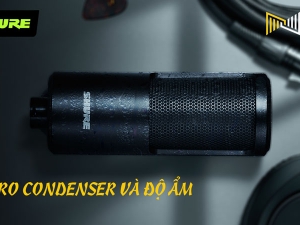Question Moisture is clearly bad for condenser mics, but I'm curious as to what extent and how it effects the mic. If my condenser has suffered some moisture damage, will it be obvious, like pops, crackles, or other clear electrical problems, or might it be a more subtle degradation of the ...
Large Diaphragm Condenser: Applications and Placement
Large diaphragm condenser microphones produce warm and unique signals that enhance solo vocals or small vocal ensembles. However, large diaphragm mics can be used for instruments, too.

| Application | Distance from source | Tips |
|---|---|---|
| Vocals and speech | 1–6 inches (2–15 cm) | Use a pop filter to prevent plosives. |
| Acoustic guitar | 6–12 inches (15–30 cm) | Place near the sound hole or the twelfth fret for a balanced, natural sound. |
| Drums | 3–6 feet (1–2 m) | Place in front of the drum kit to capture more of the kick drum, or as an overhead (above the kit, facing down) to capture more cymbals. Consider using additional Shure microphones on individual drums for more mixing flexibility and a thicker sound. |
| Strings or horns | 1–6 feet (30 cm–2 m) | For a single instrument, place the microphone close to the source. For a horn or string section, arrange players at an equal distance from the microphone. |
| Woodwinds | 2–6 inches (5–15 cm) | Experiment with placement near the sound holes and bells of woodwind instruments. |
| Amplifiers | 1–6 inches (2–15 cm) | Aim towards the center of the speaker for a clear, aggressive sound, or towards the edge of the speaker for a mellow sound. Watch for distortion. |
Shure



